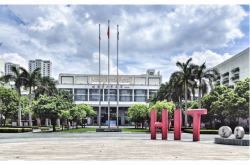Alina, please tell us a little about yourself. How long have you been working at ITMO’s Infochemistry Laboratory?
I am a Bachelor’s student at the Faculty of Biotechnologies. My program is called Food biotechnology. I have been working as a lab assistant at ITMO University for two years.
Was this your first project there?
Yes, it was my first project. I also participated in another one: making cups for the coffee that can be eaten after you finish your drink but I left it so I don’t know if it was successful or not. Funnily enough, my first project at an ITMO lab turned out to be the topic of my thesis.
Now let’s talk about your project. I did a little research before our interview and it turned out that you can make gluten-free dough even by yourself at home. What’s the difference between the dough you can make at home and the one you made at ITMO’s Infochemistry laboratory?
There are several things that are different. First of all, the dough you make at home you make for yourself, to prepare some food at home. We make the dough for automatic production so it needs to have its own unique formulation. Secondly, I tried to make gluten-free dough at home and I didn’t find it tasty. At our laboratory we, of course, work really hard so that our product would be delicious.
What products do you use to make this dough?
We use rice flour, starch and gum because they can substitute wheat, rye and barley. However, some recipes can’t be applied at big facilities because of their physical and chemical parameters. That is why we also do ultrasonic processing of components before making the dough.
This sounds interesting but could you explain why is it better or necessary to have ultrasonic processing of components?
Throughout the past years, the opportunity to modify biological processes on food manufactures using ultrasonic processing became really popular because it’s an eco-friendly and very effective way to control the parameters you need.
Also, it helps with neutralization of products without using any chemicals and provides high quality of products and food safety which is relevant in the pandemic.
Moreover, if we use an ultrasound, we end up with a more viscous product. In addition, an interesting effect of almost doubling the volume of the dough was found, which leads to the production of two to ten additional dumplings from each kilogram of dough while maintaining the original amount of ingredients.
In this way, we can produce more without increasing the initial mass of components. In this regard, in addition to the improved technology, there is also a positive economic effect.
Did you enjoy working on your project at the Infochemistry lab ?
Yes, this laboratory is fully equipped, which is great, and I really enjoyed working there.
Interview by Kseniia Efremova



